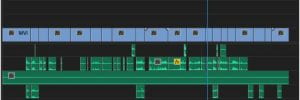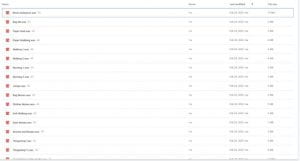Session 5 Production Project
Summary
Role
For this production project, I was the sound designer.
Intention (SMART Goal) Based on the Role (Skill Set)
Specific – I will learn how to capture consistent and high-quality sound, this is a goal because it will make the audio of the film smooth.
Measurable- I will measure my progress by recording all the sounds I know I need from a checklist, and not using production sound. I will know I met the goal when all of the sounds in the film are recorded in post-production.
Achievable – I know I am capable of achieving my goal as I have recorded audio in past films, so it would be the refining of a known skill. The motivation is to have the best possible quality sound in the film I can manage. The effort required is somewhat similar to what will be achieved.
Relevant – I am setting this goal now because having ADR is the main goal of this production project.
Time-Bound – The deadline is the first day of post-production because we need time to edit the audio into the film.
PRE-PRODUCTION – INQUIRY
Leader(s) in the Field / Exemplary Work(s)
- The two characters are voiced by the same person, and so when their lines overlap their mouths move the same, making a single line from the voice actor believable.
- Because it is a story being told, the audio switches from in-scene to out of scene seamlessly while the narrator also voices the character. The mouths of the characters also line up perfectly with what they say.
- The audio matches what the walrus says, and strikes from the background music enunciate his speech, making it flow rhythmically with the script.
Training Source(s)
- Use ADR for outside scenes, bad background noise or choosing it to improve line delivery.
- In Premiere, you can record audio directly into the software.
- Include a pre-roll to give actors time before they need to start talking
- Hold a quick rehearsal for the line, and record that rehearsal, but do not tell them it is a rehearsal, as the way they naturally say it will often be a good take.
- On additional takes, mute the previous tracks so the actor uses only the main clip.
- Go in-depth to the lines to find where words start and align the audio through that.
- Use slight stretching of the audio to better align it with the mouth of the character
- Equalize the audio to simulate distance
- Use reverb to match audio to background
- Practice on the basic mic of the computer you use
- http://capitalcomtech.info/2015/12/27/film-production-sound-designers-journal/
- This blog post by Mr. LeDuc goes over in detail what a sound designer should be accomplishing in their role, and tips on how to get the job done effectively.
- http://filmg.co.uk/files/downloads/Audio-Resource_-Notes.pdf
- This is a PDF file with helpful steps on what to do to record audio for your film, during the filming process, and even talks go over transferring those skills into post-production. It goes over terms so that it’s very hard to be confused, and even tells you how to do everything yourself.
- http://capitalcomtech.info/2016/03/29/film-sound-design-adr-automated-dialogue-replacement/
- This is another blog post by Mr. LeDuc made specifically for informing students how to record ADR, what to do, and things to look for. It has links to a Quizlet with ADR terms so that nothing is confusing and unclear.
Project Timeline
- Establish tone with director and screenwriter
- Look over the script and make any Foley sounds before you start production
- Create music to fit the film’s tone
- Mark advanced storyboard with audio implements
- Record room tone in one of the back rooms of the film classroom
- Record on-sight in production with a camera mounted mic
- Look over the edited film and take note of all the things that need to be recorded.
- Record the ADR of the actors using the shotgun mic.
- Label all sound files to make things easier for your editor
- Help the editor sync all sound files correctly with the lines spoken.
PRODUCTION – ACTION
The Gronch
Skills Commentary

In the film I utilized only ADR recorded after production, with the goal of higher quality audio not muddled by background noises. This can be seen on the timeline of the film, where you can see all the audio files used are green, meaning none of them came from the camera while we were in production.
Seen in the wide green bar stretching the length of the timeline, I had a long take of ambiance from where I recorded the other sounds in post-production. This background sound is used to make the static of the audio clips consistent and smooth.
I had multiple sources of audio throughout production, the first while filming was used to better line up audio acquired with the shotgun mic in post-production. This is seen in my bank of audio files that I used for the film.

Also evidenced by my list of audio files is that all the sound effects and Foley for the film were recorded after production. This was done to keep background static consistent and give audio we would expect as viewers from things we might not have heard from the live audio.
POST-PRODUCTION – REFLECTION
21st Century Skills
Ways of Thinking
In order to get the highest quality sound I was capable of achieving, I checked out recording equipment and spent part of a night in a desolate woodland attic recording all the Foley sounds I knew I needed, as well as all of my lines for ADR. Because of this, only about a fifth of audio was recorded in the classroom, and much time was saved that could be used for other things.
Ways of Working
The members of Team 3, even in the absence of a Trello board, kept in contact daily about what needed to get done for us to finish. Without being told to do a stand-up meeting, we would generally start each day talking about what we were all going to do that day to work towards the end goal. We didn’t give our jobs to others, but we all filled roles when it was needed in the case of absence.
Tools for Working
For this project I used YouTube tutorials on ADR, recording decks and shotgun mics, Premier Pro and Google Drive.
Ways of Living in the World
In this session more than any other, I felt a harmonious relationship with my teammates. I could rely on them and they could rely on me. In a perfect world, I would work through everything in this way. Working as a team player will definitely be useful in future careers.
Reactions to the Final Version
Keith remarked that he was, “…impressed by the amount of sound you recorded, and how clean it was that it flowed together…”
Sam had written that “Sound was well done, voices were clear and sound effects were easy to hear and understand.”
Self-Evaluation of Final Version
The story we made was simple. The premise was easy to understand and delivered more through implication than dialogue.
The film we made had an unexpected ending, made to be endearing for the audience’s benefit.
The film we made was emotional, people can probably relate to the more pessimistic person.
Our story was concrete, it had a beginning, middle and end.
What I Learned
During this session, I have learned the importance of collaboration and time management. There is not a single component of what I did during the session that would be as it is if not for the aid and guidance of my peers.
Grammar and Spelling
The tool “Grammarly” was used to check spelling and grammar in this paper.
Editor